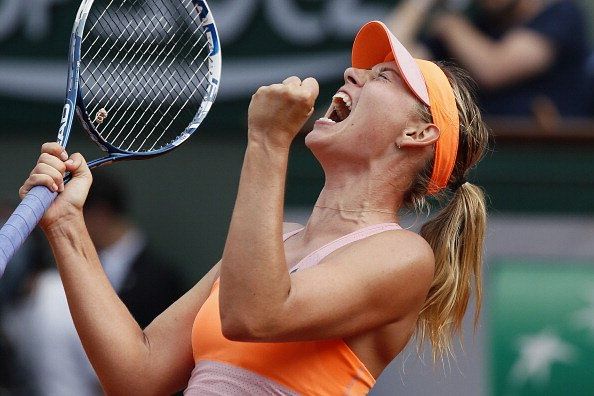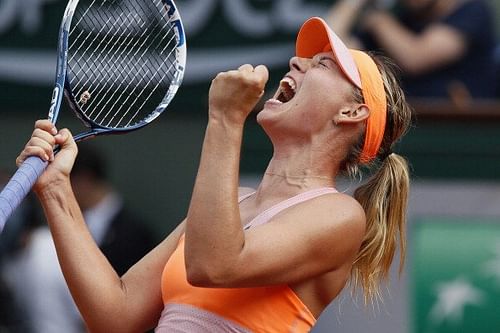
Maria Sharapova, the queen (of clay) who refused to yield

If you’ve ever watched Maria Sharapova play, you’ve probably felt that her matches should come with a ‘Do not try this at home’ warning label. She seems to do everything wrong; and not just in an ill-advised, unlearned way, but in a wildly violent one. She takes too big swings at the ball, blasts way too many errors, commits double faults by the dozens, moves like an awkward, lumbering giraffe (can we retire the ‘cow on ice’ analogy for now?) and volleys like she’s trying to wedge a brick into a solid wall. As you can guess, all of that doesn’t make for pretty viewing. And not just that; all of it also sounds like a sureshot recipe for disaster if you’re trying to actually win a tennis match.
Well, shows how much we know. Who needs aesthetic or technically sound tennis when you can have scrappy but successful tennis instead? I’m not sure if Sharapova has ever asked that question to herself, but if she has, I’m pretty sure what her immediate answer must have been. Winning is all that matters for the Russian, aesthetics and technique be damned. And that lesson was reinforced to the tennis world once again in her battling 6-4, 6-7, 6-4 win over Simona Halep in the 2014 French Open final.
This was the first three-set French Open final since 2001, and at 3 hours and 2 minutes this was also the second longest French Open final of all time. You’d think both women would be happy at producing such an emphatic advertisement of the quality of women’s tennis, but as the post-match reactions showed, that was scarcely the case. Sharapova looked relieved, pumped up, ecstatic and overwhelmed all at the same time, while Halep seemed to want nothing more than to find a corner on the court and curl up in it. The match meant a lot to both women, and it showed in the tennis that was on display.
Though this match was longer than any of Sharapova’s three consecutive three-setters leading up to the final, it wasn’t quite as nerve-racking for her camp. For one thing, Sharapova never trailed in the match after breaking back for 2-2 in the first set. In her match against Samantha Stosur she was a few points away from losing in two sets, and in her quarterfinal against Garbine Muguruza she twice had to serve to stay in the match.
For another, the contest always seemed to be on the Russian’s racquet. Halep is an excellent mover and a fine ball-striker, but her relative lack of power meant that Sharapova could dictate a majority of the points in the match, a lot of which ended in a winner from her or an unforced error. The final stats reveal that Sharapova made an astronomical 46 winners and a ghastly 52 unforced errors, while for Halep the numbers were a more modest 20 winners to 31 errors.
But what the stats don’t reveal is how hard Halep made it for Sharapova to actually put away the points. Moving with an elegance and a fluidity that’s hardly been seen since the days of Justine Henin, Halep was everywhere on the court. No matter how hard Sharapova swung her racquet, the Romanian was there, waiting to use all of that pace and redirect the ball to a completely different spot.
As has been extensively documented, Sharapova has learned to slide on her backhand side, but still struggles to move efficiently enough on the forehand wing. Halep used that to her advantage, repeatedly hitting with pace to that side and pulling the Russian off the court. Sharapova’s forehand error count piled up as the match wore on, and she made a couple of particularly costly ones in the second set tiebreak. But for every two, or three, running forehands that she missed, she made one lethal down-the-line or crosscout dagger that turned the tables of the rally. That slowly started playing on Halep’s mind (although it shouldn’t have – the odds were still in her favour), and she started going for sharper angles and higher pace on her crosscourt forehands and inside-out backhands, which eventually led to a few too many erros down the final stretch.

Another mistake that the 22-year-old Romanian made was rushing through her points on her serve when put under pressure. Sharapova has a very slow, deliberate between-points routine that helps her control the tempo of the match, and on the one occasion when Halep was even slower than Sharapova, with the Russian leading 5-3 in the tiebreaker, the results were dramatic: Halep won the next four points to clinch the set. But for the most part, Halep exhibited a Kim Clijsters-like tendency to scurry from one end of the cout to another between points, especially when put in a tight spot. While that didn’t exactly backfire completely (Halep saved an impressive 11 of the 20 break points she faced), at times it did make her rush her strokes as well, which inevitably led to errors.
Of course, all of those minor mis-steps are completely understandable given that this was the first time Halep had ever made it beyond the quarterfinal of a Major, let alone a semifinal. If anything, the way in which she stood toe-to-toe with the experienced Sharapova, refusing to cow down to the Russian’s scorching shots, steely stares or supersonic screams, is worthy of respect.
The Romanian is a natural talent and a gritty competitor, and it seems fairly certain that we’ll be seeing her in a lot more Slam finals. Most of the upcoming WTA youngsters show a predilection for blasting the cover off the ball, but Halep, with her shrewd court sense and sweetly timed strokes, is a refreshing change. You can’t teach the kind of graceful movement and purposeful defence that Halep showed all through the tournament, and the women’s tour is all the richer for it.
What you also can’t teach, of course, is making all of the clunky parts of your game work with incredible efficiency on the biggest points in a match, the way Sharapova did so frequently today. She made 12 double faults in the match, but she kept going for the second serve – there was a difference of just 8 kph in the average speed of her first and second deliveries through the match. It’s often said that the definition of insanity is doing the same thing over and over again, and expecting different results. But isn’t it also said that there is a very thin line between genius and insanity?
Of course, when she needed her serve the most – in the critical fourth game of the third set where she faced two break points – she somehow managed to produce the goods. The forehand, too, seemed to fall in place in the most important moments; just when you thought she would yield and spray another error off the wing, she miraculously pulled out a laser that left Halep, and everyone watching, gasping for breath.
Except that there was nothing miraculous about it – it was just a single-minded refusal to yield. And on clay, where she can hang around in the points even against superior ball-strikers, Sharapova has been particularly determined about her refusal to yield – this is her second French Open crown in three years, and she has lost just four matches on the surface in that span of time (out of which only one was against a player not named Serena Williams). Is it time to start calling Sharapova the Queen of Clay?
Maybe not just yet; she’s still not defeated Serena Williams on the surface, after all. But as long as other players keep knocking out the American, Sharapova seems prepared to smother into submission everyone else in her path.
If you’re an aspiring tennis player though, just one warning: do not attempt to replicate what the Russian does on the court. She can make all of those seemingly ill-fitting parts of her game work because, well, because she is Maria Sharapova.
The rest of us, unfortunately, aren’t.